Bambang Herumanta, Rizky Citra Islami
Department of Civil Engineering, Vocational School, Gadjah Mada University
Correspondence to: Bambang Herumanta, Department of Civil Engineering, Vocational School, Gadjah Mada University.
| Email: |  |
Copyright © 2022 The Author(s). Published by Scientific & Academic Publishing.
This work is licensed under the Creative Commons Attribution International License (CC BY).
http://creativecommons.org/licenses/by/4.0/

Abstract
Construction buildings and infrastructure must have an impact on the environment. The global warming issue is a trending topic discussed at the end of this decade. The development of construction is increasingly massive ay Yogyakarta City. Yogyakarta City has an area of 32,5 km² or approximately 1,02% of the Special Region of Yogyakarta area. Trademark as tourism city that stick of Yogyakarta city make 24,96% economic activities are focused on trading, hotel and restaurant. Green building concept is designed with environmental aspects in mind so that the construction impact is minimal and in line with energy saving objectives. This research’s aim is evaluating green building implementation on the buildings at Yogyakarta City. The expected output from this research is a number of evaluation from the existing buildings. This evaluation used the Greenship Rating Tools assessment criteria by adjusting the evaluation results of the application of Green Building in Yogyakarta City. There are six aspect that used to evaluate such as, appropriate site development, energy efficiency and conservation, water conservation, material resource and cycle, indoor health and comfort, also building and environment management. Each of the aspect is used to evaluate 140 building at 14 districts at Yogyakarta City. There are about 2,365 building construction units and 2,773 hotel units in the 14 districts, this research take 140 buildings as sample. The evaluation of green building implementation is using Standard of Greenship Existing Building Version 1.0 created by Green Building Council Indonesia. There are 117 points as total of the evaluation but from the evaluation, Yogyakarta City reach 50-75% in evaluation. Several aspect that can’t be optimized such as Energy Efficiency and Conservation aspect and Building Environmental Management aspect. The evaluation result can be used to suggest a policy to construct new building in Yogyakarta City.
Keywords:
Greenship, Rating tools, Green building, Evaluation
Cite this paper: Bambang Herumanta, Rizky Citra Islami, Framework for Implementing the Green Building Concept at Yogyakarta City Using Greenship Rating Tools, International Journal of Construction Engineering and Management , Vol. 11 No. 2, 2022, pp. 45-52. doi: 10.5923/j.ijcem.20221102.02.
1. Introduction
The construction process often neglects environmental balance. The United Nations report on a publication entitled "Buildings and Climate Change" states that 30% -40% of energy is used for buildings. The construction sector also contributes to producing carbon emissions more than 40%, using a large amount of natural materials, contributing waste, and reducing water catchment areas and green areas (Sucipto, 2017). The development of the city of Yogyakarta is also due to the increasingly massive construction developments. Yogyakarta City has an area of 32.5 km² or approximately 1.02% of the area of the Special Region of Yogyakarta. The Tourism City Trademark attached to the City of Yogyakarta makes 24.96% of economic activity focused on trade, hotels and restaurants. When viewed on hotel booking applications, the number of hotels in Yogyakarta is 2,773 units, the majority of which are located in Yogyakarta City. Based on this data, it can be imagined how much carbon emissions are produced in these buildings.In order to support environmental sustainability and development sustainability in the city of Yogyakarta, it is time for the city government to implement policies related to building construction in Yogyakarta. During this time, building construction has only been regulated in the ownership policy of Land and Building Tax (PBB) and Certificate of Acceptability of Function (SLF). The concept of Green Buildings (Green Buildings) is designed with environmental aspects in mind so that the construction impact is minimal and in line with energy saving objectives. Indonesia already has a special institution that handles this, namely the Green Building Council Indonesia (GBCI). One of the programs is a green building certification activity in Indonesia based on an rating scale system called Greenship.According to the World Green Building Council, A ‘green’ building is a building that, in its design, construction or operation, reduces or eliminates negative impacts, and can create positive impacts, on our climate and natural environment. Green buildings preserve precious natural resources and improve our quality of life.Indonesia as members of World Green Building Council, they convene businesses and governments to collectively drive environmental, economic and social impact within the built environment on a national, regional and global scale. The membership levels for World Green Building Councils is Established,in Asia-Pacific region.The Indonesian government encourages commercial building owners to use eco-friendly, energy saving buildings to support the Green Building program. Several strategies that can be pursued to succeed in implementing Green Building are five stages of Go Green (Armstrong, 2008) including:1. Reducing the consumption of resources (energy and water)2. Reducing waste and making recycling efforts3. Building materials (eliminating hazardous materials, choosing environmentally friendly materials, using materials that do not cause holes in the ozone)4. Environment inside the building (air quality, room temperature, maintenance of air conditioning and air ducts)5. Concern for occupants / building users (communication between owners and occupants / building users). This communication is very important as an effort to reduce negative environmental impacts.The Green Building Council Indonesia (GBCI) is a non-government and non-profit organization that is committed to educating the public for the implementation of sustainable building. The assessment tool Greenship has the characteristics of each country to accommodate local interests. There are 6 (six) aspects assessed using Greenship (GBCI, 2017):1. Appropriate Site Development,2. Energy Efficiency and Conservation,3. Water Conservation,4. Sources and Material Cycle,5. Air Quality and Air Comfort,6. Building and Environment Management.The greenship method building assessment guide is divided based on its application which includes, Neighborhood, Homes, New Buildings, Existing Buildings and Interior Space with different assessment criteria. This assessment system really helps a city in its efforts to implement the concept of green building to support saving the environment. This research was conducted to evaluate the suitability of the existing building conditions based on the principles of environmental sustainability in the city of Yogyakarta. The evaluation results are expected to become a reference for the management of the Yogyakarta City development plan to make it greener and more organized.
2. Research Method
The research method that will be used at this stage is the evaluative method. The evaluative method is used to evaluate the criteria for existing buildings in the city of Yogyakarta. The research tool used is the rating tools that exist in the Greenship criteria for existing building. The criteria reviewed include:Table 1. Appropriate Site Development
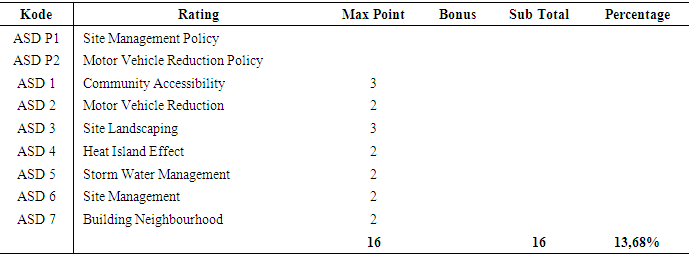 |
| |
|
Table 2. Energy Efficiency and Conservation
 |
| |
|
Table 3. Water Conservation
 |
| |
|
Table 4. Material Resource and Cycle
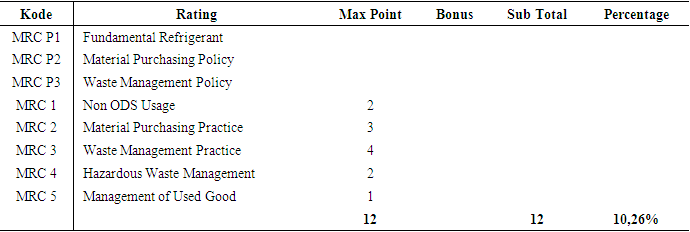 |
| |
|
Table 5. Indoor Health and Comfort
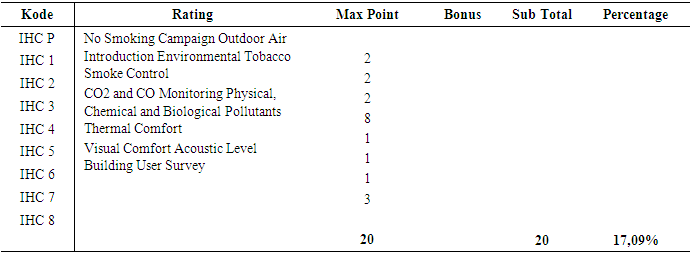 |
| |
|
Table 6. Building Environment Management
 |
| |
|
3. Results and Discussion
Yogyakarta has approximately 2,365 building construction units and 2,773 hotel units. The area owned by the city of Yogyakarta is approximately 32.50 km² divided into 14 districts. Figure 1 describes the percentage of sub-district area in Yogyakarta City.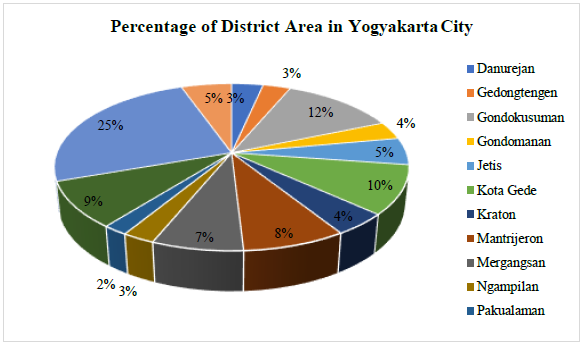 | Figure 1. Percentage of District Area in Yogyakarta City |
Based on this data it can be imagined the density of the buildings in Yogyakarta that has been trademarked as a Tourist City. Nearly 80% of the area is built up areas. This research took a sample of buildings in the city of Yogyakarta with building function criteria based on the Minister of Public Works Regulation Number 29/PRT/M/2006 concerning Guidelines for Building Technical Requirements. Based on the policy, building functions are divided into 5 (five), namely:1. Residential function,2. Religious function,3. Business function,4. Socio-cultural function, and5. Special functions.The sample was determined by conducting a quick survey of 1,272 building units in the city of Yogyakarta, and then 140 building units were selected to be evaluated using the Greenship Rating Tools. Figure 2 shows the number of existing buildings in Yogyakarta City based on the results of a quick survey.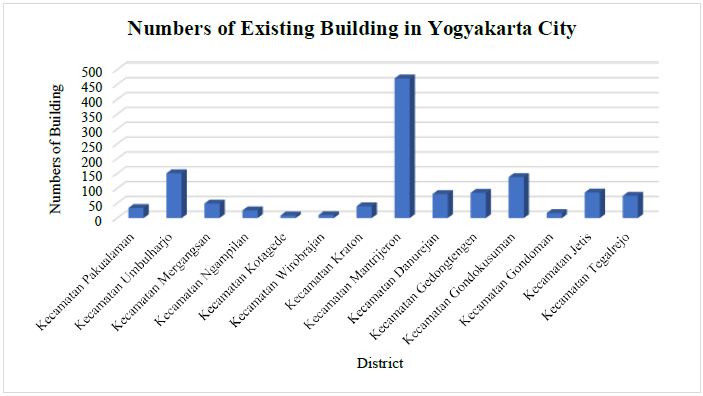 | Figure 2. Number of Existing Buildings in Yogyakarta City (quick survey result) |
Based on the results of a quick survey, it is known that the highest number of existing buildings is in Mantrijeron District with 471 units and the lowest is in Gondomanan District. Mantrijeron sub-district is the center of offices and trade in Yogyakarta City, this can be seen from the number of buildings in that location. Meanwhile, Gondomanan District is a center for shopping and cultural tourism. The buildings are only limited to shops, markets, and cultural tourism. Detailed evaluation of each Greenship component will be discussed based on the components of each aspect.1. Appropriate Land (Appropriate Site Development)Evaluation of the right components of land seen from the building owner's commitment to emissions reduction and environmental management, accessibility provided, as well as the implementation of Standard Operating Presedur (SOP) with good building management. The maximum total value based on the standard is 16 with the percentage of the overall criteria Greenship is 13,68%. The results of the evaluation show that the application of land-use criteria in the city of Yogyakarta has an average value of 11.686 or 9.99% of the overall percentage. The highest score was found in Gondokusuman District and the lowest was in Tegalrejo District.2. Energy Efficiency and ConservationDiscussion on energy efficiency and conservation is about optimizing building performance efficiency as well as monitoring and control activities for daily energy use. The survey was conducted by knowing the savings efforts made by the building manager.The maximum total value based on the standard is 36 with the percentage of the overall criteria Greenship is 30.77%. The evaluation results showed that the application of energy efficiency and conservation criteria in the city of Yogyakarta has an average value of 24.45 or 20.90% of the overall percentage. The highest score was found in Gondokusuman District and the lowest was in Umbulharjo District.3. Water ConservationWater conservation is related to the use of water resources in buildings, water management to the use of water recycling as a fulfillment of needs. The maximum total value based on the standard is 20 with the percentage of the overallcriteria Greenship is 17.09%. The evaluation results show that the application of water conservation criteria in the city of Yogyakarta has an average value of 14.286 or fulfills 12.21% of the overall percentage. The highest score was found in Gondokusuman sub-district and the lowest was in Kotagede sub-district.4. Material Resource and CycleThe discussion on the source and the cycle of material rated of checks on the use of building materials used, maintenance policies with fixed uses green materials, waste management and the implementation of reduce, reuse, recycle (3R) on the building Building. The maximum total value based on the standard is 12 with the percentage of the overall criteria Greenship is 10.26%. The evaluation results show the application of source criteria and material cycles in Yogyakarta has an average score of 9,279 or it fulfills 7.93% of the overall percentage. The highest value was found in Gondokusuman District and the lowest value was in Umbulharjo District.1. Air Quality and Air Comfort (Indoor Health and Comfort)Evaluation of air quality and air comfort is carried out by measuring air quality in the building, implementing a smoking ban and asking about the comfort of the building by users of the building. The maximum total value based on the standard is 20 with the percentage of the overall Greenship criteria is 17.09%. The evaluation results show that the application of the criteria for air quality and comfort in the city of Yogyakarta has an average value of 14.029 or fulfills 11.99% of the overall percentage. The highest value was found in Gondokusuman District and the lowest value was in Kotagede district.2. Building and Environment ManagementEvaluation of the building’s environmental management is done by checking the long-term of operations plan and maintenance of the building, and training are held regularly associated with the Health Safety Environment and Security (HSES). The maximum total value based on the standard is 13 with the percentage of the overall criteria Greenship is 11.11%. The evaluation results show the application of environmental management criteria for buildings in the Yogyakarta city has an average value of 7.76 or fulfills 6.63% of the overall percentage. The highest value was found in Gedongtengen district and the lowest in Kraton District. The results of the evaluation of the overall Greenship criteria in Yogyakarta City are presented in Figure 3.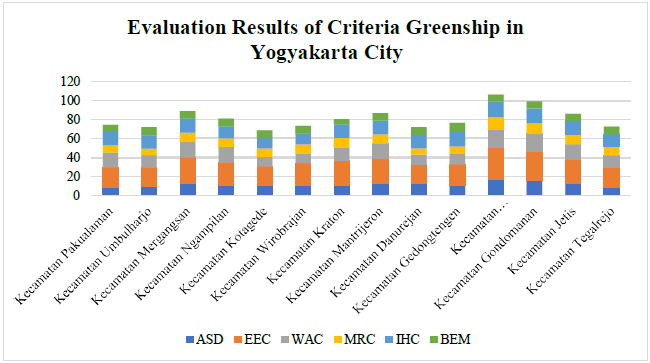 | Figure 3. Evaluation Results of Criteria Greenship in Yogyakarta City |
While the total value of the evaluation against of Greenship criteria, It is known that the Gondokusumo District has the highest score with a total value of 106.5 and the lowest value is the Kotagede District with a total value 68.9. The details of the value can be seen in Figure 4.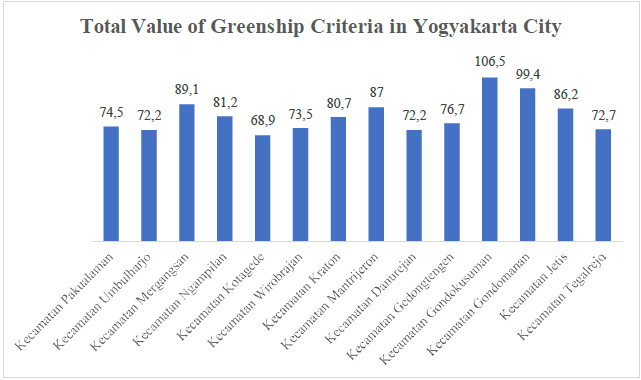 | Figure 4. Total Value of Greenship Criteria in Yogyakarta City |
The results showed that the application of the green building concept in Yogyakarta City was not fully effective. This is because based on policy, the Yogyakarta City government does not have an operational standard for building construction that adopts the green building concept. The policy was launched is the SLF policy of the central government and which has recently applied for pressing the increas number of hotels in Yogyakarta city via Moratorium No. 111 of 201. Comparison of the results of the evaluation with a standard percentage Greenship values are presented in Figure 5.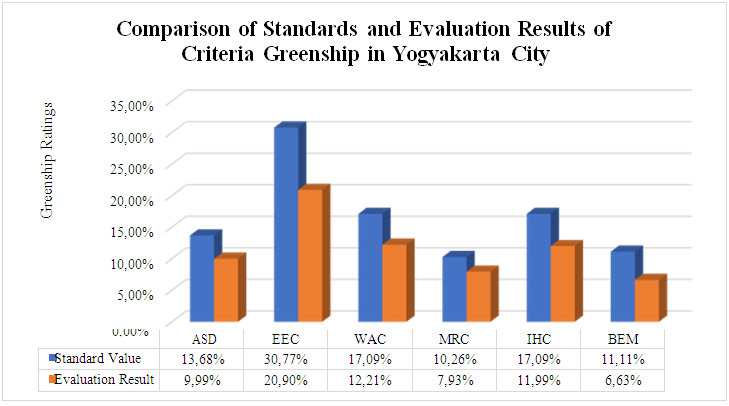 | Figure 5. Comparison of Standards and Evaluation Results of Criteria Greenship in Yogyakarta City |
If the generalized results comparison, it is known that the application of the green building concept to buildings in Yogyakarta City reaches 50-75% of the standard values applied to the criteria. But the sustainability of management must be improved in order to achieve the success of Yogyakarta as a city with a concept green. The criteria that needs to be observed is energy efficiency, which based on the evaluation results is still 20.9% of the standard which should be 30.77%. In practice, not many building have provided restrictions or carried out energy efficiency campaigns such as limiting power outlets, sticking stickers or suggesting savings.The implementation of policies related to green building is also absolutely necessary to maintain the preservation and regularity of the structuring of the city of Yogyakarta. Figure 6 try to figure out the implementation framework of green building concept in Yogyakarta City based on analysis result and discussion with expertise.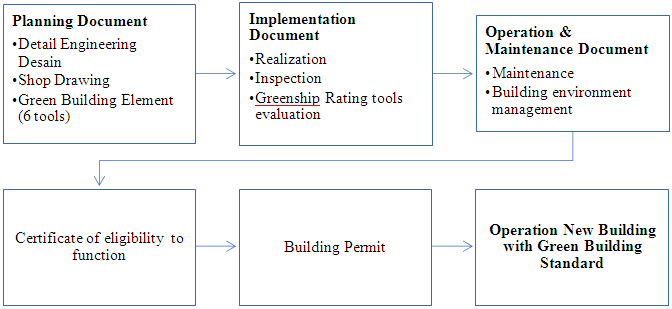 | Figure 6. Framework of Green Building Implementation |
4. Conclusions
The results of this research indicate that the application of the green building concept in Yogyakarta City is still not very effective. This can be seen from the comparison value of the percentage of standard application from the evaluation results which shows the value for (1) ASD 9.99% from 12.68%; (2) EEC 20.9% from 30.77%; (3) WAC 12.21% from 17.09%; (4) MRC 7.93% from 10.26%; (5) IHC 11.99% from 17.09%; and (6) BEM 6.63% from 11.11%.
References
| [1] | Adji, Hadjar Seti. (2016). Green Building and Green Construction. Jakarta: Engineer Weekly. Armstrong, B. (2008). Green building strategies. Manitoba Business, 30 (2), ABI/INFORM Complete pg.14. |
| [2] | Green Building Council Indonesia. (2016). Greenship Existing Building. |
| [3] | Nabila, Soraya, dkk. (2018). Penerapan Green Building di Perkantoran Menara Suara Merdeka, Semarang. Nature: National Academic Journal of Architecture. Vol.5, Nomor 2, hlm 124-134. |
| [4] | Triwidiastuti, Sri. (2017). Model Green Building di Indonesia Berbasis Konsep Kualitas DMAIC SIX SIGMA. http://repository.ut.ac.id/7075/1/UTFMIPA2017-06-sri.pdf. |
| [5] | Utomo, Christiono. (2012). Penilaian Kriteria Green Building pada Gedung Teknik Sipil ITS. Surabaya: Jurnal Teknik ITS Vol.1, No.1 ISSN 2301-9271. |
| [6] | Mutinta Sichali, Luke John Banda, 2017, Awareness, Attitudes and Perception of green building Practices and Principles in the Zambian Construction Industry, International Journal of Construction Engineering and Management. 2017 6 (5). doi: 10.5923/j.ijcem.20170605.04, http://article.sapub.org/10.5923.j.ijcem.20170605.04.html. |
| [7] | Shazmin Shareena Ab. Azis, Ibrahim Sipan, Maimunah Sapri, 2013, The Potential of Implementing Property Tax Incentives on green building in Malaysia, American Journal of Economics. 2013 3 (2). doi: 10.5923/j.economics.20130302.01, http://article.sapub.org/10.5923.j.economics.20130302.01.html. |
| [8] | World Green Building, https://worldgbc.org/our-green-building-councils. |









 Abstract
Abstract Reference
Reference Full-Text PDF
Full-Text PDF Full-text HTML
Full-text HTML




